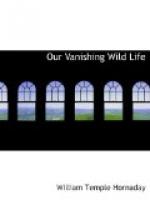Every breeding wild animal craves seclusion and entire immunity from excitement and all forms of molestation. Nature simply demands this as her unassailable right. It is my firm belief that any wild species will breed in captivity whenever its members are given a degree of seclusion that they deem satisfactory.
With species that have not been shot down to a point entirely too low, adequate protection generously long in duration will bring back their numbers. If the people of the United States so willed it, we could have wild white-tailed deer in every state and in every county (save city counties) between the Atlantic and the Rocky Mountains. We could easily have one thousand bob white quail for every one now living. We could have squirrels in every grove, and songbirds by the million,—merely by protecting them from slaughter and molestation. From Ohio to the great plains, the pinnated grouse could be made far more common than crows and blackbirds.
Inasmuch as all this is true,—and no one with information will dispute it for a moment,—is it not folly to seek to supplant our own splendid native species of game birds (that we never yet have decently protected!) with foreign species? Let the American people answer this question with “Yes” or “No.”
The methods by which our non-game birds can be encouraged and brought back are very simple: Protect them, put up shelters for them, give them nest-boxes in abundance, protect them from cats, dogs, and all other forms of destruction, and feed those that need to be fed. I should think that every boy living in the country would find keen pleasure in making and erecting nest-boxes for martins, wrens, and squirrels; in putting up straw teepees in winter for the quail, in feeding the quail, and in nailing to the trees chunks of suet and fat pork every winter for the woodpeckers, nuthatches, and other winter residents.
Will any person now on this earth live long enough to see the present all-pervading and devilish spirit of slaughter so replaced by the love of wild creatures and the true spirit of conservation that it will be as rare as it now is common?
But let no one think for a moment that any vanishing species can at any time be brought back; for that would be a grave error. The point is always reached, by every such species, that the survivors are too few to cope with circumstances, and recovery is impossible. The heath hen could not be brought back, neither could the passenger pigeon. The whooping crane, the sage grouse, the trumpeter swan, the wild turkey, and the upland plover never will come back to us, and nothing that we can do ever will bring them back. Circumstances are against those species,—and I fear against many others also. Thanks to the fact that the American bison breeds well in captivity, we have saved that species from complete extinction, but our antelope seems to be doomed.
It is because of the alarming condition of our best wild life that quick action and strong action is vitally necessary. We are sleeping on our possibilities.




